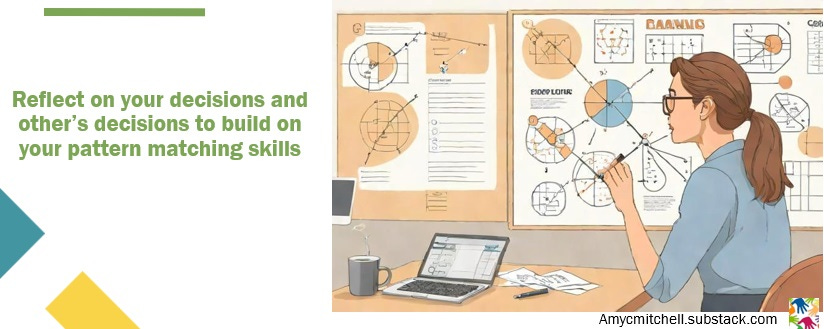Developing Good Judgment
The hidden power of good judgment in product management
After the last two articles on Superpowers for Product Managers, a few readers asked about developing their good judgment skills.
To delve into good judgment, let's follow a product leader for a day and get insights into her judgment calls.
Judgment Call 1: Gathering Multiple Perspectives
First situation - the product leader separately asks two product managers about the strategy to handle a recent customer request
Why does she do this?
She is justifying the decision she has already made
She is testing if the product managers are ready for the next level
She is coaching both product managers in decision-making
She is looking for diverse perspectives and is interested in feedback
Answer: 3 and 4 - review diverse perspectives before making a decision
Answer 1 or 2, justifying a decision or testing product managers, isn't efficient.
How does this situation relate to good judgment?
A key aspect of good judgment is gathering diverse viewpoints and challenging your assumptions. The product leader knows from prior experience that she is missing key information about the customer request, the history with the customer, and customers with similar requests.
By working with each product manager separately, the product leader practices good judgment by:
Gathering the perspectives of others to fill knowledge gaps
Interpreting the reason for the customer's request
Making informed decisions with multiple insights
Seek diverse points of view to challenge your assumptions.
Judgment Call 2: Reflect on Prior Decisions
Second situation - the product leader's business forecast is so conservative that stakeholders will question the investment decision
Why doesn't she provide an aggressive forecast for the hot, new product?
She doesn't know how much effort has gone into the product
She isn't factoring in the market growth rate
She didn't factor in the big sales pipeline
She reviewed the growth rate of similar products after launch
Answer: 4 - she reviewed similar product launches inside and outside of her organization. Similar products took a while after launch to make significant revenue.
Answer 1 doesn't apply - the amount of effort is not relevant to customers
Answers 2 and 3 are key for an investment decision - but not relevant for new products that take time to generate significant business
How does this situation relate to good judgment?
Pattern matching helps you hone your judgment. By reflecting on prior decisions - your decisions or someone else's decision - you can recognize recurring issues. By identifying a pattern, such as the slow adoption of a new product, you know the likely outcome.
By reflecting on past decisions, you can improve your judgment daily by:
Noticing patterns in the product life cycle
Learning from mistakes and outcomes
Applying the patterns to decisions in the future
Reflect on your decisions and other's decisions to build your pattern-matching skills.
Judgment Call 3: Scenario Planning
Third situation - The product leader refuses to halt committed development work to take on a new large customer
Why doesn't she pivot to a new opportunity?
She didn't meet with the customer or understand the growth potential
She doesn't want to upset the development team with a change
She doesn't know how hard it is to find customers
She analyzed multiple scenarios to find the best business outcome
Answer 4 - she looked at the timing of onboarding the new customer until profitability vs the timing of delivering as planned to the market. She found the better business outcome is the broader market instead of a single customer.
Answers 1, 2 and 3 are not relevant to a business outcome.
How does this situation relate to good judgment?
Considering the consequences and opportunities in different scenarios leads to improving your judgment. Preserving relationships with sales and development is very important. By looking at the different business outcomes, the product leader can show reasoning that supports the decision-making. This approach leads sales and development to a shared understanding of the opportunity choice.
By practicing scenario planning, you can improve your judgment continuously:
Calculating the business outcome of best-case and worst-case analysis
Build on relationships by discussing possible scenarios
Improve risk management skills
Develop contingency plans
Open-minded reflection on the outcomes of the scenarios
Consider the consequences and opportunities of your decisions by using scenario planning.
Conclusion - Build your good judgment skills every day
Whether you have been a product manager for a minute or a decade, you have many chances to build your good judgment skills. By using these practices, product managers can exercise their judgment:
Gather other's perspectives - seek diverse viewpoints and challenge your assumptions
Reflect on prior decisions - find patterns that can help you next time
Scenario planning - consider the consequences and opportunities of your decisions
By taking these steps, you can gradually enhance your good judgment and become a more effective decision-maker in driving the success of your product and team.
Want to know what happened after a recent article? Premium subscribers get the inside story of a recent newsletter. Last week’s backstory was about mistakes product managers make in monitoring engineering efforts. Read it to learn how to add product manager value during development. Teamwork with Engineering
Connect to Amy on LinkedIn, Threads, Instagram and X/Twitter






Great read, Amy! Filling in the knowledge gaps with diverse perspectives is very important. Once you make a decision you should monitor the outcomes and reassess the decision making process to see what could be improved in the future. I think this is extremely important for high risk high reward decisions that are hard to reverse. For the decisions that are easily reversed moving fast and adjusting afterwards is better.